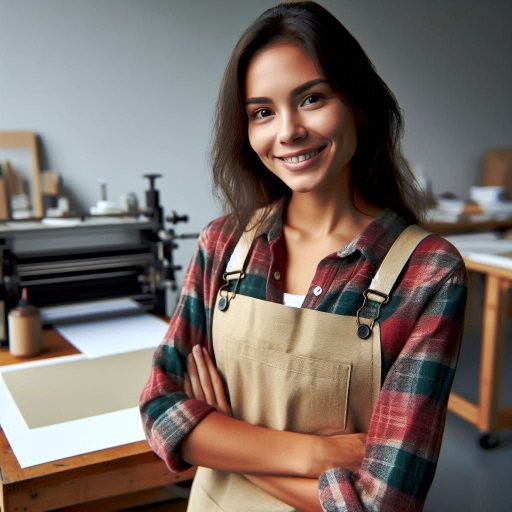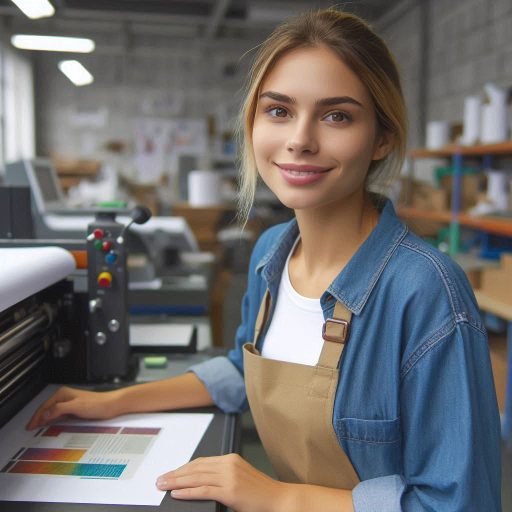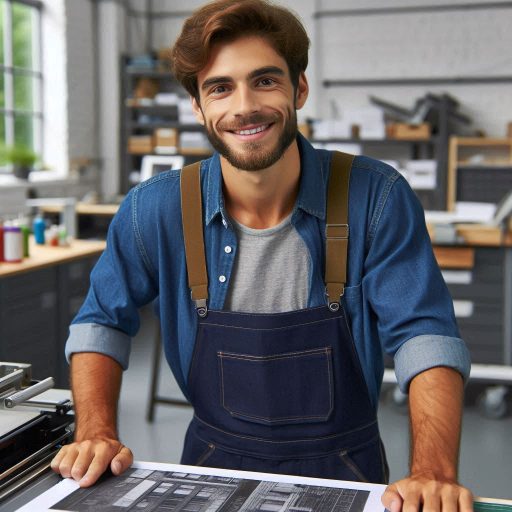Introduction
Documenting your printmaking process is crucial for several reasons.
It helps you track your artistic development and techniques.
By recording each step, you can analyze and refine your methods.
This practice also aids in preserving your creative journey.
When you revisit your documentation, you gain insights into your growth as an artist.
Additionally, detailed records ensure you can reproduce successful techniques in future projects.
Documentation also helps you troubleshoot problems and understand what adjustments are necessary for improvement.
For artists, this process serves as a valuable learning tool.
It captures the nuances of your work, from initial sketches to final prints.
Detailed records of materials and techniques used can be invaluable for teaching or collaboration.
Furthermore, documenting your process builds a portfolio of your work that showcases your evolution.
It also allows you to reflect on your artistic choices and their outcomes.
By maintaining thorough documentation, you ensure that your creative processes are preserved for future reference.
Documenting each step of your printmaking process offers significant benefits for both personal reference and future projects.
For personal reference, it provides a comprehensive guide to your techniques and choices.
This documentation becomes a valuable resource when you wish to recreate or build upon previous works.
It also helps in maintaining consistency in your style and approach.
For future projects, detailed records enable you to replicate successful methods and avoid past mistakes.
They offer insights into the effectiveness of different materials and techniques.
This information can guide your experimentation and innovation in future prints.
Transform Your Career Today
Unlock a personalized career strategy that drives real results. Get tailored advice and a roadmap designed just for you.
Start NowAdditionally, documentation assists in creating a cohesive body of work by linking various projects through shared techniques or concepts.
In summary, documenting your printmaking process enhances your artistic practice.
It ensures that valuable information is preserved and accessible for future use.
This practice not only aids in personal growth but also supports the successful execution of future projects.
Tools for documenting
Documenting your printmaking process is an essential part of being an artist.
Not only does it help you keep track of your progress, but it also allows you to share your work with others.
By documenting your process, you can create a visual record of how your prints evolve from start to finish.
Here are some tools you can use to document your printmaking process effectively:
Camera or smartphone for taking photos
One of the easiest ways to document your printmaking process is by taking photos of each step.
A camera or smartphone with a decent resolution can capture the details of your work and help you see how your prints develop over time.
Make sure to take clear, well-lit images to accurately document your process.
Notebook or sketchbook for jotting down notes
Keeping a notebook or sketchbook handy while you work can be incredibly helpful for documenting your process.
Jotting down notes about the materials you use, the techniques you try, and any discoveries you make along the way can provide valuable insights into your creative process.
You can also use your notebook to sketch out ideas or designs, helping you visualize your prints before you create them.
Video camera for recording the process in real-time
If you want to take your documentation to the next level, consider using a video camera to record your printmaking process in real-time.
This can give viewers a detailed look at how you create each print, from carving the block to pulling the final impression.
You can narrate the video to explain your techniques and share your thoughts as you work, creating a comprehensive record of your process.
Overall, documenting your printmaking process can enhance your artistic practice and provide valuable insights into your work.
Whether you use a camera, notebook, or video camera, finding a method that works for you can help you capture the essence of your creative journey.
Remember to stay consistent with your documentation and review your progress regularly to see how far you’ve come as an artist.
Transform Your Career Today
Unlock a personalized career strategy that drives real results. Get tailored advice and a roadmap designed just for you.
Start NowRead: Marketing Strategies for Printmakers
Step-by-step documentation
Initial Sketches and Ideas
Before diving into the actual printmaking process, it is essential to start with the initial sketches and ideas.
This stage sets the foundation for your artwork and helps you visualize the end product.
Take your time to brainstorm ideas and sketch out different concepts until you find the one that resonates with you the most.
Photographing Each Stage of the Carving or Etching Process
Once you have finalized your sketch, it’s time to transfer it onto your printing surface through carving or etching.
Document each stage of this process by taking photographs.
This will not only serve as a visual record of your work but also help you track your progress and identify any areas that may need adjustment.
Recording Mixing Inks and Printing Techniques
After preparing your printing surface, the next step is to mix your inks and choose the appropriate printing techniques.
Record this process by documenting the type of inks you are using, the color combinations, and the printing methods employed.
This documentation will be valuable for future reference and replication of the same techniques.
By following these step-by-step documentation practices, you can create a comprehensive record of your printmaking process.
Remember, documenting your journey not only helps you refine your skills but also allows you to share your creative process with others.
Read: Printmaking for Children’s Art Education
Keeping a detailed log
When it comes to documenting your printmaking process, one of the most crucial steps is keeping a detailed log.
By recording your journey from start to finish, you not only create a valuable resource for future reference but also gain insights into your artistic growth.
Here are some key components to include in your log:
Noting any challenges or breakthroughs during the process
- Documenting the obstacles you faced while creating your prints and how you overcame them can provide invaluable information for future projects.
- Recording any breakthroughs or moments of inspiration will help you understand what works best for you as an artist.
- By taking note of both challenges and breakthroughs, you create a comprehensive record of your artistic journey.
Writing down specific details such as paper type, ink color, and pressure
- Include the type of paper you used for each print, noting its weight, texture, and color.
- Record the specific ink colors you used, including any custom mixes or special preparations.
- Document the pressure settings on your press or any adjustments you made during the printing process.
- By capturing these specific details, you create a reference guide for future projects and can easily replicate successful outcomes.
Overall, keeping a detailed log of your printmaking process is essential for both personal and professional growth.
Not only does it help you track your progress and learn from your experiences, but it also serves as a valuable resource for troubleshooting and improving your techniques.
Remember to update your log regularly and take the time to reflect on your journey as an artist.
Happy printing!
Transform Your Career Today
Unlock a personalized career strategy that drives real results. Get tailored advice and a roadmap designed just for you.
Start NowRemember, the devil is in the details, so make sure to capture every aspect of your printmaking process for a comprehensive log.
Read: Tips for Setting Up a Printmaking Studio

Organizing and storing documentation
When it comes to documenting your printmaking process, organization is key.
Here are some tips on how to effectively organize and store your documentation:
Create a digital folder for photos and videos
One of the most convenient ways to store your documentation is by creating a digital folder on your computer or cloud storage.
This folder should contain all the photos and videos you have taken throughout the printmaking process.
Make sure to organize them in a logical order, such as by date or by specific project.
Keep a physical binder for notes and sketches
In addition to digital files, it’s also helpful to keep a physical binder for your notes and sketches.
This binder can hold any handwritten notes, sketches, or print proofs that you want to keep for reference.
By having a physical copy, you can easily flip through your notes and sketches without having to scroll through digital files.
Label everything clearly for easy reference in the future
Labeling is crucial when it comes to organizing your documentation.
Make sure to label each file, both digital and physical, with clear and descriptive names.
This will help you find what you need quickly and easily in the future.
You can use a consistent naming convention, such as including the date and project name in the file name.
By following these tips for organizing and storing your documentation, you can keep track of your progress and refer back to specific steps in the printmaking process with ease.
Read: Understanding Color Theory in Printmaking
Sharing Your Process
Sharing your printmaking process not only highlights your work but also builds a community around your art.
Here’s how to effectively share your journey.
Consider Creating a Blog or Social Media Account
A blog or social media account can serve as a platform for documenting and sharing your printmaking process.
Choose a platform that fits your style—whether it’s Instagram for visuals or a blog for detailed posts.
Transform Your Career Today
Unlock a personalized career strategy that drives real results. Get tailored advice and a roadmap designed just for you.
Start NowRegularly update your account with insights into your techniques, inspirations, and challenges.
This consistent presence helps build an audience interested in your creative journey.
Share Photos or Videos of Your Printmaking Journey
Photos and videos are powerful tools for showcasing your printmaking process.
Capture each step, from initial sketches to final prints.
Detailed shots of your workspace, tools, and techniques make your process more relatable and engaging.
Short videos or time-lapses can reveal the transformation of your work in an engaging way.
High-quality visuals can help potential followers understand and appreciate the intricacies of your process.
Engage with Followers and Fellow Artists for Feedback and Inspiration
Interaction with your audience and peers enriches your creative journey.
Respond to comments and questions to build a connection with your followers.
Join conversations in artist communities to exchange ideas and feedback.
Constructive critiques and encouragement from fellow artists can provide new perspectives and improve your skills.
Engaging with others fosters a supportive network and can inspire new directions in your work.
Sharing your printmaking process not only showcases your art but also opens up opportunities for growth and community building.
By creating a blog or social media presence, sharing visual content, and engaging with others, you enhance your visibility and connect with those who share your passion.
Reflecting on the documentation
Review your process after completing a project
After completing a printmaking project, it is important to take the time to reflect on your documentation process.
This reflection can help you identify areas where you excelled and areas where you can improve for future projects.
One of the first things to consider when reflecting on your documentation process is how well you captured each step of your printmaking journey.
Did you take detailed notes or photographs at every stage of the process?
Next, think about how easy it was to follow your documentation during the printmaking process.
Were there any gaps in your notes or photographs that made it difficult to recreate a step or technique?
Transform Your Career Today
Unlock a personalized career strategy that drives real results. Get tailored advice and a roadmap designed just for you.
Start NowIdentify areas for improvement or experimentation in future prints
Reflect on the overall organization of your documentation.
Did you have a clear system in place for keeping track of your process, or were things scattered and disorganized?
Consider the level of detail in your documentation.
Did you capture important details such as the types of materials used, the settings on your equipment, and any unexpected challenges you encountered during the process?
Think about how well your documentation captured the essence and intention of your printmaking project.
Did you effectively convey the inspiration behind your work and the emotions you were trying to evoke?
Identifying areas for improvement or experimentation in future prints based on your reflection is a crucial step towards growing as a printmaker.
Consider the following questions as you plan for future projects:
What techniques or processes could you explore or refine in future prints based on your reflection?
Are there new materials or tools you want to experiment with in your next project, and how can you document your experience with these new elements?
Reflect on any challenges or limitations you encountered during your previous project.
How can you address these obstacles in future prints to achieve better results?
Consider seeking feedback from other printmakers or artists on your documentation process.
What insights or suggestions can they offer to help you enhance your documentation skills?
By taking the time to reflect on your documentation process and identify areas for improvement or experimentation in future prints, you can enhance your printmaking practice and continue to evolve as an artist.
Using documentation for future projects
One of the key benefits of documenting your printmaking process is the ability to refer back to your notes and photos for inspiration.
By reviewing the work you have already done, you can build upon previous techniques or try new approaches based on past experiences.
Refer back to your notes and photos for inspiration
- Notes and photos serve as a visual record of your creative journey, allowing you to revisit ideas and concepts that may have sparked your interest in the past.
- Looking back at your documentation can help reignite the passion you felt for a particular project or technique, inspiring you to take it in new directions.
- Documenting your process can also help you identify patterns in your work, such as recurring themes or color palettes, that you may want to explore further.
Build on previous techniques or try new approaches based on past experiences
- By documenting your printmaking process, you can track the evolution of your skills and ideas over time, allowing you to see how far you have come and where you can go next.
- Reviewing your past work can help you identify areas where you can improve or experiment with different methods, expanding your creative repertoire and pushing your boundaries.
- Documenting your process can also be a valuable tool for sharing your journey with others, whether through social media, exhibitions, or collaborations with other artists.
Overall, using documentation for future projects can enhance your artistic practice by providing a source of inspiration, a roadmap for growth, and a means of sharing your creative process with others.
Don’t underestimate the power of revisiting your past work and using it as a springboard for future endeavors.
Conclusion
Keeping a record of your printmaking process is essential for artists looking to grow and develop their skills.
Transform Your Career Today
Unlock a personalized career strategy that drives real results. Get tailored advice and a roadmap designed just for you.
Start NowBy documenting each step, you can reflect on your work, identify areas for improvement, and share your techniques with others in the creative community.
Documenting your printmaking process allows you to track your progress over time.
It provides insight into your artistic journey, helping you understand what works well and what could be done differently in future projects.
Start by taking photos or videos of each stage of your printmaking process.
Make notes on your thoughts, techniques used, and any challenges faced.
Keep a sketchbook or journal to record your ideas and inspirations.
Sharing your documentation with others in the creative community can inspire fellow artists and foster collaboration.
It also opens up opportunities for feedback and support, which can lead to growth and improvement in your work.
Documenting your printmaking process can be a valuable tool for growth and development as an artist.
It encourages reflection, improvement, and sharing with others in the creative community.




